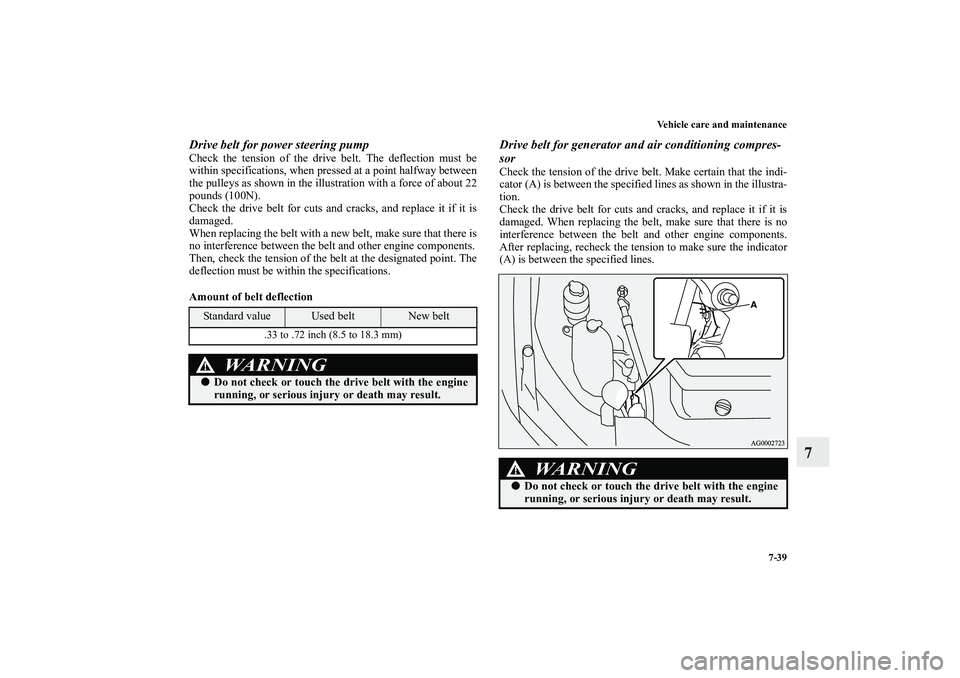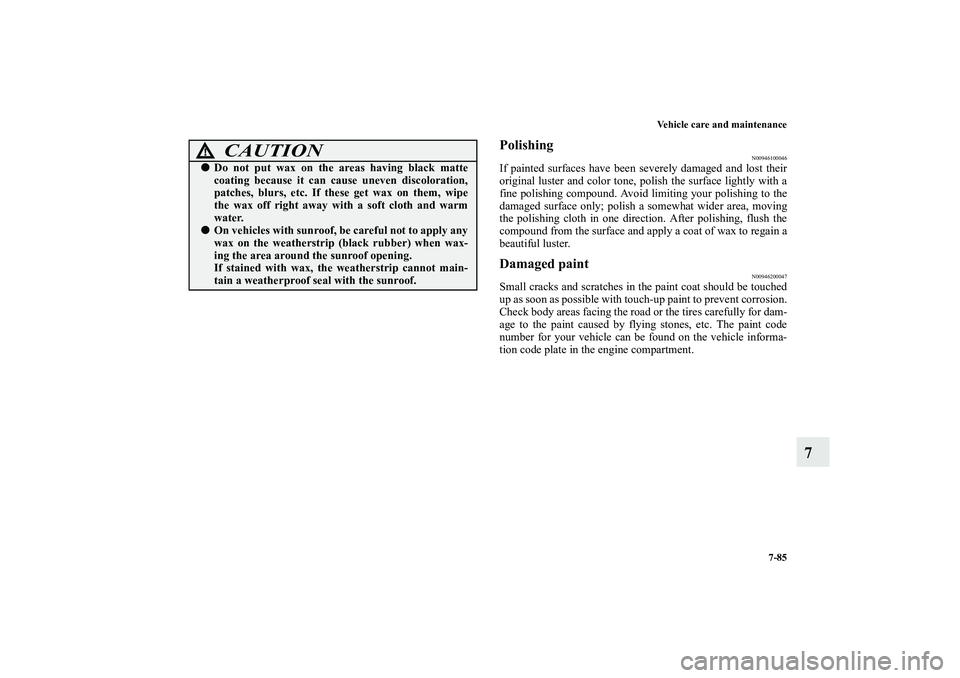Page 635 of 714
7-38 Vehicle care and maintenance
7
3.0 liter models
WA R N I N G
!�
Do not check or touch the drive belt with the engine
running, or serious injury or death may result.
1- Power steering pump pulley
2- Crank shaft pulley
3- Generator pulley
4- Air conditioning pulley
5- Drive belt for power steering pump
6- Drive belt for generator and air conditioning compressor
BK0115300US.book 38 ページ 2009年7月16日 木曜日 午前9時13分
Page 636 of 714

Vehicle care and maintenance
7-39
7
Drive belt for power steering pumpCheck the tension of the drive belt. The deflection must be
within specifications, when pressed at a point halfway between
the pulleys as shown in the illustration with a force of about 22
pounds (100N).
Check the drive belt for cuts and cracks, and replace it if it is
damaged.
When replacing the belt with a new belt, make sure that there is
no interference between the belt and other engine components.
Then, check the tension of the belt at the designated point. The
deflection must be within the specifications.
Amount of belt deflection
Drive belt for generator and air conditioning compres-
sorCheck the tension of the drive belt. Make certain that the indi-
cator (A) is between the specified lines as shown in the illustra-
tion.
Check the drive belt for cuts and cracks, and replace it if it is
damaged. When replacing the belt, make sure that there is no
interference between the belt and other engine components.
After replacing, recheck the tension to make sure the indicator
(A) is between the specified lines.
Standard value
Used belt
New belt
.33 to .72 inch (8.5 to 18.3 mm)
WA R N I N G
!�
Do not check or touch the drive belt with the engine
running, or serious injury or death may result.
WA R N I N G
!�
Do not check or touch the drive belt with the engine
running, or serious injury or death may result.
BK0115300US.book 39 ページ 2009年7月16日 木曜日 午前9時13分
Page 637 of 714

7-40 Vehicle care and maintenance
7
Exhaust system
N00942200094
The best way to keep carbon monoxide gas from entering
inside your vehicle is to have the engine exhaust system prop-
erly serviced.
Have a competent mechanic inspect the complete exhaust sys-
tem and nearby body areas for broken, damaged, deteriorated,
or mispositioned parts if you notice any of the following:�
A change in the sound of the exhaust system
�
The smell of exhaust fumes inside the vehicle
�
The underside or rear of the vehicle is damaged
Also check the exhaust system each time the vehicle is raised
for lubrication, oil changes, or required service. Any open
seams or loose connections could let dangerous exhaust fumes
seep into the luggage compartment and passenger compart-
ments.
Check for any of the following conditions:�
Check for holes or exhaust gas leaks caused by corrosion
or damage.
�
Check the joints and connections for looseness or exhaust
gas leaks.
�
Check the rubber hangers and brackets for damage.
Timing belt
N00942300079
The timing belt should be replaced with a new one at the mile-
age listed in the “WARRANTY AND MAINTENANCE
MANUAL”.Hood lock release mechanism and safety catch
N00942500101
The hood lock release mechanism and hood safety catch should
be checked, cleaned, and oiled when needed for easy move-
ment and to stop rust and wear. Use Multipurpose Grease
NLGI Grade 2 sparingly for all sliding parts of the hood latch
and release lever. Work the grease into the hood lock mecha-
nism until all the movable surfaces are covered.
Also, put a light coat of the same grease on the safety catch
wherever moving parts touch.
WA R N I N G
!�
Carbon monoxide gas from your vehicle’s exhaust is
poisonous. Breathing these fumes can cause uncon-
sciousness or death.
BK0115300US.book 40 ページ 2009年7月16日 木曜日 午前9時13分
Page 682 of 714

Vehicle care and maintenance
7-85
7
Polishing
N00946100046
If painted surfaces have been severely damaged and lost their
original luster and color tone, polish the surface lightly with a
fine polishing compound. Avoid limiting your polishing to the
damaged surface only; polish a somewhat wider area, moving
the polishing cloth in one direction. After polishing, flush the
compound from the surface and apply a coat of wax to regain a
beautiful luster.Damaged paint
N00946200047
Small cracks and scratches in the paint coat should be touched
up as soon as possible with touch-up paint to prevent corrosion.
Check body areas facing the road or the tires carefully for dam-
age to the paint caused by flying stones, etc. The paint code
number for your vehicle can be found on the vehicle informa-
tion code plate in the engine compartment.
�
Do not put wax on the areas having black matte
coating because it can cause uneven discoloration,
patches, blurs, etc. If these get wax on them, wipe
the wax off right away with a soft cloth and warm
water.
�
On vehicles with sunroof, be careful not to apply any
wax on the weatherstrip (black rubber) when wax-
ing the area around the sunroof opening.
If stained with wax, the weatherstrip cannot main-
tain a weatherproof seal with the sunroof.CAUTION
!
BK0115300US.book 85 ページ 2009年7月16日 木曜日 午前9時13分